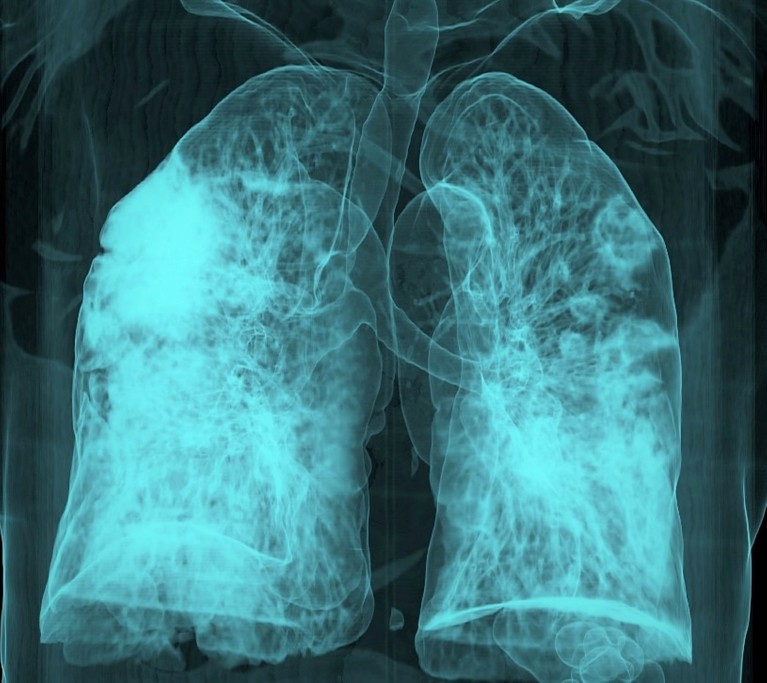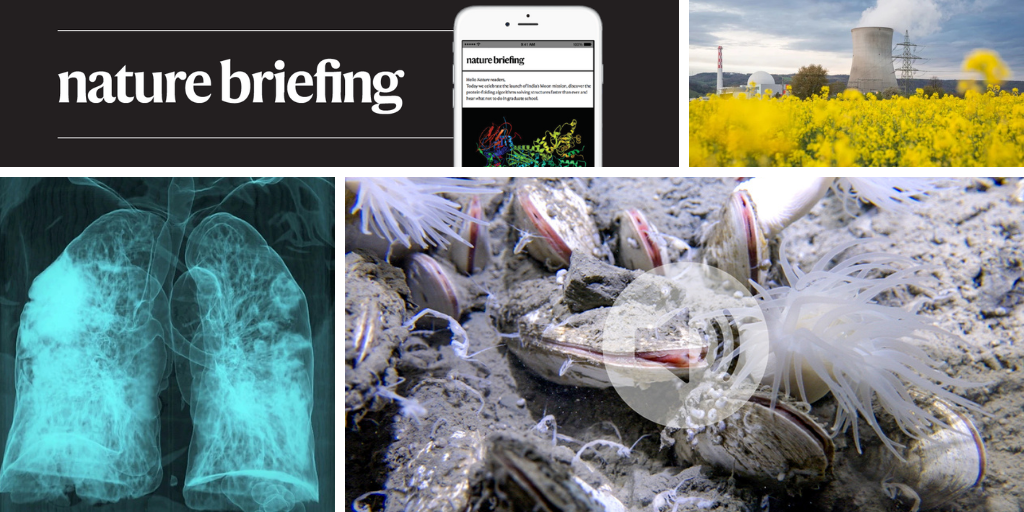You have full access to this article via your institution.
Hello Nature readers, would you like to get this Briefing in your inbox free every day? Sign up here.

People infected with the virus that causes COVID-19 (lungs of a person with the disease shown) have a nearly twofold increased risk of cancer-related death, data show.Credit: Rajaaisya/Science Photo Library
Common respiratory illnesses such as COVID-19 or flu can awaken dormant cancer cells in mice. When a tumour grows, some cells can detach, travel round the body and ‘hide’ in tissues such as the lungs after treatment. Researchers found that the release of an immune molecule called interleukin-6, triggered by respiratory illnesses, wakes up these dormant cells — but only for a short time. This means that the infections do not directly cause cancer, but make it more likely that a future threat could revive the disease.
Physicists have caught neutrinos from a nuclear reactor using a device weighing just a few kilograms. Detecting neutrinos usually requires the particles to collide with an electron, proton or neutron — an extremely infrequent event that requires detectors weighing tonnes or even thousands of tonnes. With the new ‘mini’ neutrino-detector, called CONUS+, researchers report having seen around 395 collision events in 119 days of operation. The technique opens new ways to stress-test the known laws of physics and to detect the copious neutrinos produced in the hearts of collapsing stars.
NISAR — an astonishingly high-resolution satellite — launched yesterday on a mission to map changes on Earth’s surface in unprecedented detail. A collaboration between NASA and the Indian Space Research Organisation, NISAR will track everything from sinking croplands to crumbling ice sheets and flood-ravaged terrain. For NASA, the excitement of the launch is tinged with worry that the drastic cuts to the agency’s budget proposed by the administration of US President Donald Trump will make NISAR one of the last major Earth-observing satellites that the agency builds for years.
The sneezing, itchy eyes and coughing elicited by some allergens are caused by proteins creating holes in airway cells. Researchers found that two proteins in the mould Alternaria alternata, which causes allergic reactions in about 5% of people, trigger the airway inflammation seen during allergic reactions. Together, the proteins, called Aeg-S and Aeg-L, create a pore in the membranes of cells lining the nose, throat and lungs. This allows calcium ions to enter the cells, which triggers an immune response that causes the symptoms of allergy.
Features & opinion
Inspired by largely-forgotten early 20th-century experiments, a small group of scientists are investigating ‘aneural’ memory. Their question: can individual cells ‘remember’ certain stimuli and adapt their behaviour accordingly? Their research has produced some evidence that cells from slime moulds to human kidney cells can ‘learn’, which hints that chemical patterns within cells could constitute some form of memory. But getting wider acceptance might be a challenge — the scientific definition of ‘memory’ is largely based on behaviour, which can’t always be observed in single cells.
Reference: Nature Communications paper
A scientist and their spaceship find ways to procrastinate in Things I miss about civilization.
Between 6,000 and 9,000 metres below the surface of the Pacific ocean lives a complex community of creatures that seem to use bacteria-derived methane as a source of energy. These organisms, including tubeworms and bivalve molluscs, form part of the deepest complex ecosystem ever discovered — far beyond the reach of the sun’s light. “This ecosystem is populated by very strange animals,” says geobiologist and study co-author Dominic Papineau. “I think it’s a remarkable finding to discover a new ecosystem on Earth that was never really conceptualized to exist before.”
Nature Podcast | 33 min listen
Or get the gist in Nature’s 2 minute video
Subscribe to the Nature Podcast on Apple Podcasts, Spotify or YouTube Music, or use the RSS feed.
Today, Leif Penguinson is taking a dive at a waterfall at Lushan Geopark in Jiujiang, China. Can you find the penguin?
The answer will be in Tuesday’s e-mail, all thanks to Briefing photo editor and penguin wrangler Tom Houghton.
This newsletter is always evolving — tell us what you think! Please send your feedback to [email protected].
Thanks for reading,
Jacob Smith, associate editor, Nature Briefing
• Nature Briefing: Careers — insights, advice and award-winning journalism to help you optimize your working life
• Nature Briefing: Microbiology — the most abundant living entities on our planet — microorganisms — and the role they play in health, the environment and food systems
• Nature Briefing: Anthropocene — climate change, biodiversity, sustainability and geoengineering
• Nature Briefing: AI & Robotics — 100% written by humans, of course
• Nature Briefing: Cancer — a weekly newsletter written with cancer researchers in mind
• Nature Briefing: Translational Research — covers biotechnology, drug discovery and pharma


